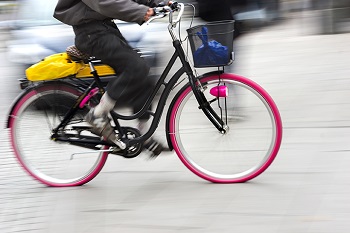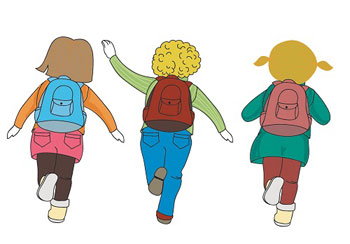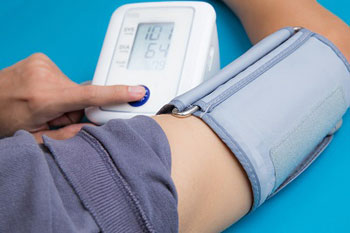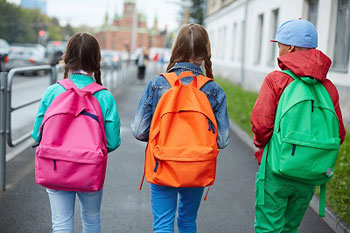Kids’ Travel section
Travel Green from Home to School
The transport sector in Northern Ireland accounts for 23% of greenhouse gas emissions which are associated with climate change. Walking or cycling to school is not only a way to lessen these emissions but also a very effective way of increasing physical fitness, which can reduce the chance of heart disease, strokes, diabetes, obesity, cancer and depression in later life.
Discover more about travel

Barack Obama has stated that "the issue of climate change is one that we ignore at our own peril...we are condemning future generations to global catastrophe." We all need to accept that climate change is a reality. We need to recognise that the choices we make now will shape our opportunities well into the future. The amount of carbon released into the atmosphere is measured in tonnes, with the average person in the EU emiting 11 tonnes of CO2 per year. Northern Ireland has the worst carbon footprint in the UK; this is mainly due to above average use of oil and coal for heating. We all – at school, at home, in our communities and in our workplaces – have a part to play.
Did you know? In Denmark, bicycles outnumber cars by two to one. This means there is less need for parking spaces or road infrastructure in cities.
Cycling and health

Getting on your bike regularly not only gets you where you want to go faster than a car, it protects you against a wide range of ill health, and also makes you feel better. Cycling is good for your heart and health. Everyday cycling, where the exercise leaves you breathing heavily but not being out of breath, is an effective and enjoyable form of aerobic exercise. This is the type of exercise that is most effective at promoting good health. For example, cycling reduces the risk of serious conditions such as heart disease, high blood pressure, obesity and the most common form of diabetes. One rough calculation suggests that new cyclists covering short distances can reduce their risk of death (mainly due to the reduction of heart disease) by as much as 22 per cent.
Cyclists breathe in less fumes than car drivers
If you are worried about traffic fumes, there may be no need. Cyclists and pedestrians actually absorb lower levels of pollutants from traffic fumes than car drivers.
Health benefits of walking

There are numerous benefits of walking. If a daily fitness walk could be put in a pill, it would be one of the most popular prescriptions in the world. It has so many health benefits. Walking can reduce the risk of many diseases - from heart attack and stroke to hip fracture and glaucoma. These may sound like claims on a bottle of snake oil, but they're backed by major research. Walking requires no prescription, the risk of side effects is very low, and the benefits are numerous: Combined with healthy eating, physical activity is key to any plan for long-lasting weight control. Keeping your weight within healthy limits can lower your risks of type 2 diabetes, heart disease, stroke, cancer, sleep apnea, and osteoarthritis.
Controlling your blood pressure

Physical activity strengthens the heart so it can pump more blood with less effort and with less pressure on the arteries. Staying fit is just as effective as some medications in keeping down blood pressure levels.
A steady routine is the most important factor in getting the most out of your exercise programme. Walking for at least 30 minutes a day, 5 or more days a week is recommended.
Use these tips to keep you on track:
- During your walks, you should be able to maintain a conversation. If you're breathing too lightly, increase your pace. If you can't catch your breath, slow it down.
- Walk around the local area after lunch or dedicate 15 minutes to walking up and down stairs. Climbing is an excellent way to strengthen your heart.
- In the evenings with your parents permission trade a half hour of TV for a brisk stroll around the block. Take a friend with you for company or get the whole family involved.
Children Travelling to School

Did you know? It takes about 20-30 minutes to walk 1.25 miles. Walking is a great way to get fit and healthy and you can chat to your friends on the way to school too. A 3 mile journey (1.5 miles to school and 1.5 miles home from school) would fill 60 balloons of CO2. Can you find out the distance in miles from your home to school and add up how many balloons of CO2 it would be?
The Translink Eco-Schools Travel Challenge
The Translink Eco-Schools Travel Challenge encourages school pupils and parents across Northern Ireland to move away from private car use and instead adopt more environmentally-friendly travel modes such as walking, cycling, bus and train travel for the school run.
The Challenge assists schools in achieving the prestigious and internationally-recognised Eco-Schools Green Flag Award and requires Key Stage 1 – 3 classes to monitor pupil travel patterns over a 4-week period.
Find out more about the Translink Eco-Schools Travel Challenge.
Useful Links

- The main Translink website to help you plan your journeys.
- Travelwise is an initiative to encourage the use of sustainable transport options such as walking, cycling, public transport or car sharing.
- Science related – detailed outline of major pollutants caused from transport related emissions www.eta.co.uk/env_info/emissions
- This is a charity that aims to increase sustainable modes of transport - lots of resources regarding information about cycling, the links between the physical and mental benefits of exercise and active travel, ways of encouraging greener travel www.sustrans.org.uk
- Spreadsheet allowing you to calculate the food miles for a combination of food choices for particular meals. www.climatechoices.org.uk/docs/food_miles.xls
- User friendly tool that allows you to calculate your environmental impact of your personal journeys throughout Europe. www.ecopassenger.org/

